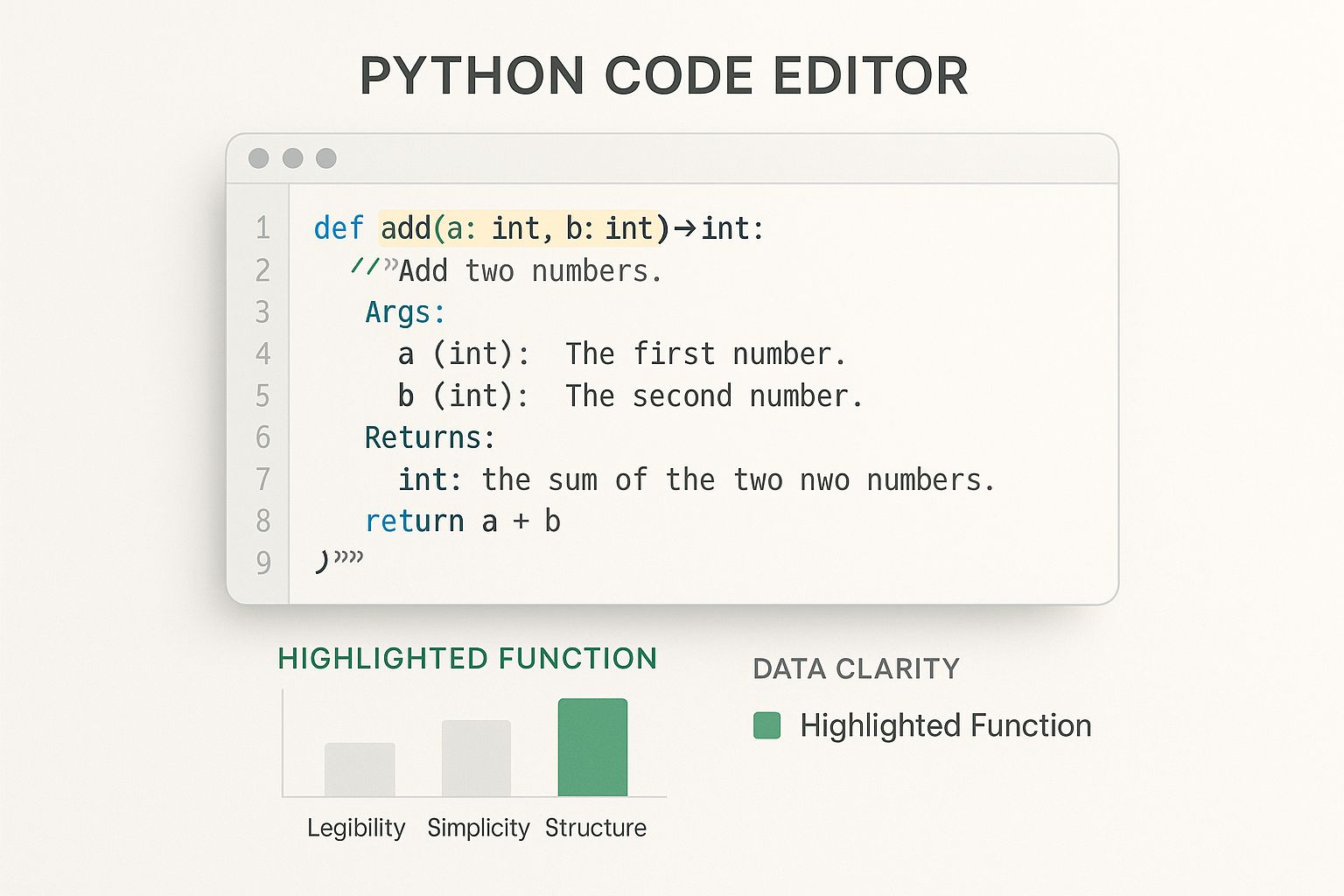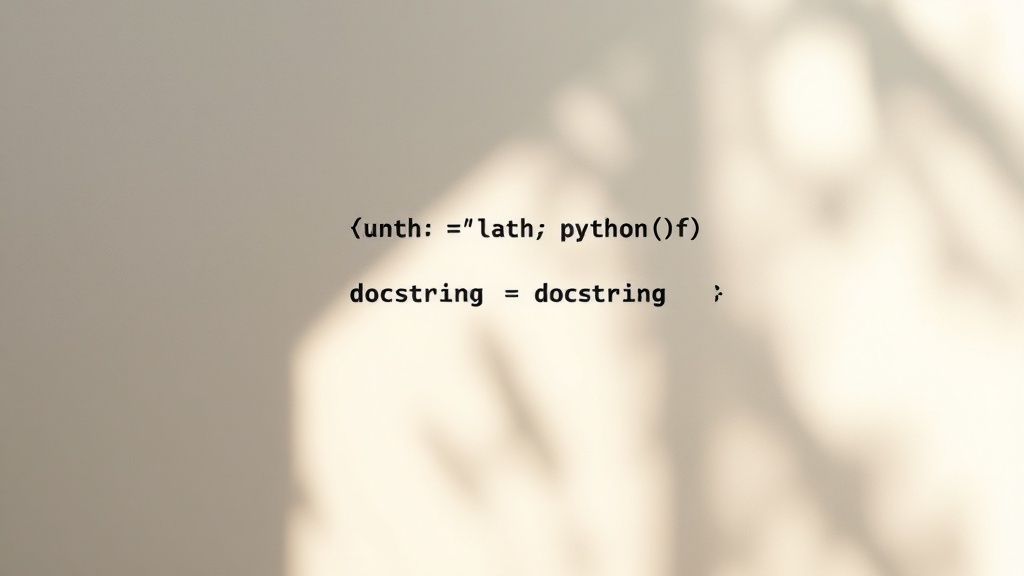Go beyond the basics of the Python function doc. Learn to write clear docstrings, automate with Sphinx, and use best practices for maintainable code.
In Python, a docstring lives right at the top of a module, function, class, or method. Unlike a regular comment, it becomes the object’s __doc__ attribute and remains accessible at runtime. You can call it up with help() or have your IDE surface it as you type.
Before we go further, let’s look at the essential pieces every function docstring should include.
Below is a quick summary of the elements PEP 257 says you need:
Each component ensures your code speaks for itself, reducing the guesswork when someone else picks it up. Tired of writing this boilerplate? DocuWriter.ai can generate PEP 257–compliant docstrings for your Python functions in seconds, so you can focus on building.
Getting your code to run is just the start. Real craftsmanship shows when your code reads like a story. A solid docstring does more than explain—it shapes your function’s identity. When you pause to write one, you’re setting clear expectations about what the function does, what it needs, and what it sends back.
On top of that, modern IDEs and Python’s built-in help() function make these docstrings instantly available. No more digging into implementation details to understand your own code.
Good docstrings aren’t a luxury—they’re an investment. Spend a few extra minutes now, and you’ll reap benefits later:
Ultimately, treating each docstring as part of your development workflow builds a foundation that’s easier to scale and maintain.
If you’d rather skip the manual grind, DocuWriter.ai can generate PEP 257–compliant docstrings for your Python functions instantly—so you can spend more time writing code and less time writing docs.
You can write a docstring, sure. But writing one that’s actually useful? That comes down to consistency. Without a shared format, your documentation will turn into a chaotic mess of different styles, leaving both your fellow developers and automated tools completely lost. Picking a single convention is the first step to making every python function doc predictable, parsable, and genuinely clear.
This isn’t just about making things look pretty; it’s a core part of keeping a project maintainable. When your team agrees on a format, everyone instinctively knows where to look for parameters, return types, and potential errors. This kind of uniformity is exactly what allows tools like Sphinx to crawl your code and spin up beautiful, searchable documentation websites automatically.
Google’s Python style guide is legendary for a reason: it prioritizes readability above all else. Their docstring format follows the same philosophy. It uses simple, clean headers like Args: and Returns: without any complicated markup, which makes it incredibly easy to write and, more importantly, to read right inside your code editor.
It’s a fantastic choice for projects where you just need to get the point across clearly. Think internal APIs or teams that want a low-friction way to get started with standardized documentation.
def calculate_area(length: float, width: float) -> float:
"""Calculates the area of a rectangle.
Args:
length (float): The length of the rectangle.
width (float): The width of the rectangle.
Returns:
float: The calculated area of the rectangle.
Raises:
ValueError: If either length or width is negative.
"""
if length < 0 or width < 0:
raise ValueError("Length and width must be non-negative.")
return length * widthJust look at how a well-structured docstring shows up in an editor. It gives you immediate context without having to jump to a separate documentation site.

This approach effectively turns your IDE into a dynamic documentation browser, putting all the critical details right at your fingertips.
If you’re building something that needs rich, cross-referenced documentation, then reStructuredText (reST) is the industry standard. This is the format that powers Sphinx, the undisputed king of documentation generators in the Python world. Yes, the syntax is a bit more verbose—you’ll be using directives like :param and :returns—but that extra structure is what unlocks its most powerful features.
With reST, you can create links between functions, classes, and modules, weaving together a deeply interconnected knowledge base. For large libraries or public-facing APIs, this is invaluable. The Python standard library is the perfect example. Take a look at the statistics module’s source; you’ll see how functions like mean() are documented with explicit parameters and StatisticsError exceptions, all with helpful examples.
Born out of the scientific computing world, the NumPy style is purpose-built for documenting complex mathematical and scientific functions. Visually, it feels a bit like the Google style, but it uses its own section headers and a distinct underline format (e.g., Parameters\n----------).
This format really shines when you’re dealing with functions that have a ton of parameters, complicated return types (like tuples of arrays), or need space for detailed mathematical notes. If your work involves data science, machine learning, or any kind of heavy numerical computation, the NumPy convention will feel right at home and meet the expectations of that community.
So, which one is for you? It’s less about finding the “best” style and more about finding the right fit for your project’s personality and goals.
I’ve put together a quick comparison to help you see the differences at a glance.
Choosing a docstring format is a key decision that impacts readability, tool compatibility, and overall maintainability. This table breaks down the three most popular styles to help you decide which one best suits your project’s needs.
Ultimately, the best choice depends on your audience and the complexity of your codebase.
Here’s my rule of thumb:
The most critical part is to just pick one and stick with it. Consistency is what turns a good python function doc into a great one.
Of course, manually enforcing this consistency across a team can be a pain. DocuWriter.ai takes that work off your plate by generating perfectly formatted docstrings in whichever style you choose, letting you focus on writing code while we handle the documentation.
Writing a solid python function doc is the crucial first step, but the real magic happens when you transform those docstrings into a polished, accessible resource for your team or users. Let’s be honest, nobody wants to manually build and maintain a documentation website. It’s tedious, error-prone, and takes you away from writing actual code.
Thankfully, the Python world is full of incredible tools designed to automate this exact process. They take your inline documentation and spin it up into a professional, searchable website. This is what truly separates a bunch of scripts from a maintainable, long-lasting project. By generating docs directly from your code, you create a single source of truth that’s far less likely to go stale.

Before you go installing third-party packages, you should know that Python comes with a handy little documentation generator right out of the box: pydoc. It’s a fantastic, no-fuss tool for a quick inspection of a module or for generating simple HTML files straight from your terminal.
There’s no setup needed. If you have Python, you have pydoc. Want to see it in action? Try running it on one of Python’s own standard libraries.
python -m pydoc -w collectionsThat one command spits out an HTML file (collections.html) in your current directory, laying out all the classes and functions inside the collections module. It’s a lightning-fast way to get a readable overview of any Python file.
While pydoc is perfect for quick checks or small internal projects, it has its limits. When you’re ready for something more powerful and flexible, it’s time to bring in the industry standard.
Sphinx is the undisputed king of documentation generators in the Python community. It’s used by thousands of projects, including the official Python documentation itself. It takes your docstrings (it especially loves reStructuredText) and builds a beautiful, modern, and feature-rich documentation site.
Getting a Sphinx project off the ground is surprisingly simple. First, you’ll need to install it.
pip install sphinxOnce that’s done, pop over to your project’s root directory and run the quickstart utility.
sphinx-quickstartThis handy script will walk you through a series of questions to set up your documentation structure. It creates a docs directory with a few key files, most importantly conf.py and index.rst.
To get Sphinx talking to your code, you just need to tweak a couple of things in conf.py:
sys.path.insert(0, os.path.abspath('.')) and uncomment it. This points Sphinx to your Python modules.**autodoc** extension: Add 'sphinx.ext.autodoc' to the extensions list. This is the bit of magic that actually pulls the documentation from your docstrings.With the configuration ready, you can now tell Sphinx which modules you want to document. Open up your index.rst file and use the automodule directive.
.. automodule:: your_module_name
:members:All that’s left is to build the site. From your docs directory, just run:
make htmlSphinx will now comb through your code, extract the docstrings, and generate a complete HTML site in the _build/html folder. Just like that, you have a professional-grade documentation website, complete with a search bar, cross-referencing, and a clean theme—all from the python function doc you were already writing.
For a deeper dive into these workflows, especially for larger systems, see how you can auto-generate API documentation.
Of course, writing and maintaining all these docstrings by hand can still be a drag. DocuWriter.ai automates the creation of high-quality, Sphinx-compatible docstrings, letting you focus on building features while we handle the documentation groundwork for you.

Most docstrings end up paraphrasing code instead of explaining the intent behind it. Yet that intent—why you chose a particular approach—is what turns documentation into a living guide. When someone revisits your function months later, it’s this context that prevents wasted time and confusion.
Not every reader needs the same level of detail. An external consumer of your public API is only concerned with the function’s inputs, outputs, and error conditions. Your teammates, on the other hand, can see the implementation, so they need higher-level insights.
Real-world data is messy. Does your function handle an empty list, None, or an unusually large payload? Document every scenario explicitly. If you picked a faster but more complex algorithm, say so. Those few lines of explanation can save hours of debugging later.
For deeper strategies on crafting robust, future-proof docs, check out these essential code documentation best practices.
Even well-meaning developers can trip over a few hazards:
Keeping your docstrings accurate by hand is tough. That’s where tools like DocuWriter.ai come in—they draft context-aware docstring suggestions you can review and polish, so you never overlook critical details.
Let’s be honest: the most tedious part of documenting a Python function is just starting. Manually typing out the summary, parameters, and return values for every single function feels like a chore, especially when you’re staring down a massive codebase.
This is where modern AI tools are completely changing the game. They turn documentation from a manual grind into a quick, assisted process.
AI can scan a function’s signature, its internal logic, and its return statements to spit out a surprisingly accurate docstring draft in seconds. This first pass handles all the boilerplate, freeing you up to focus on the important details and nuanced explanations that only a human can really provide. You’re not writing from scratch anymore; you’re editing and refining.
This shift is a huge deal for day-to-day development. A tool like DocuWriter.ai, for instance, can plug right into your IDE and document an entire module with a single command. It gives you a consistent, properly structured starting point that already follows conventions like PEP 257. For a full walkthrough, you can check out our guide on how to use AI for code documentation in our tutorial.
The result? Developers can produce better documentation, faster than ever before.